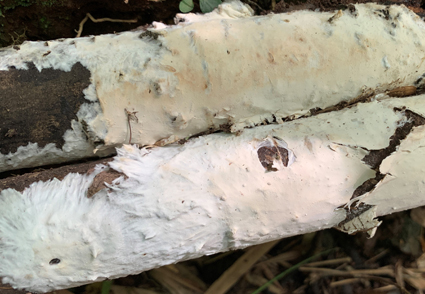Abstract
A new species of Xenasmatella, based on morphology, and molecular analysis (using the nuc rDNA ITS1-5.8S-ITS2 (ITS) dataset), was found growing on the underside of rotten bamboo in Yunnan Province, China. X. roseobubalina is characterized by annual, resupinate basidioma with a pinkish buff hymenophore, a monomitic hyphal system, thin-walled generative hyphae with clamp connections, abundant crystalline matter among the hyphae, the absence of cystidia and cystidioles, and broadly ellipsoid to subglobose basidiospores measuring 3.8–5 × 3.3–4 μm. We present the new species with illustrated description and comparisons to closest species as well as a key to the species of Xenasmatella known from China.
References
Dai, Y.C. (2010) Hymenochaetaceae (Basidiomycota) in China. Fungal Diversity 45: 131–343. https://doi.org/10.1007/s13225-010-0066-9
Dai, Y.C. (2011) A revised checklist of corticioid and hydnoid fungi in China for 2010. Mycoscience 52: 69–79. https://doi.org/10.1007/S10267-010-0068-1
Donk, M.A. (1963) The generic names proposed for Hymenomycetes – XIII. Taxon 12 (4): 153–168. https://doi.org/10.2307/1216184
Duhem, B. (2010) Deux corticiés nouveaux méditerranéens à spores allantoïdes. Cryptogamie Mycologie 31: 143–152.
Felsenstein, J. (1985) Confidence intervals on phylogenetics: an approach using bootstrap Evolution 39: 783–791. https://doi.org/10.2307/2408678
Gruhn, G., Gérard, M. & Trichies, G. (2021) Quelques Aphyllophorales non poreìes, rares ou remarquables, observeìes dans le deìpartement de la Mayenne (France). Bulletin de la Société Mycologique de France 137 (1–4): 1–60.
Hall, T.A. (1999) Bioedit: A user-friendly biological sequence alignment editor and analysis program for Windows 95/98/NT. Nucleic Acids Symposium Series 41: 95–98.
Hjortstam, K. & Larsson, K.H. (1987) Additions to Phlebiella (Corticiaceae, Basidiomycetes), with notes on Xenasma and Sistotrema. Mycotaxon 29: 315–319.
Hjortstam, K. & Ryvarden, L. (2005) New taxa and new combinations in tropical corticioid fungi, (Basidiomycotina, Aphyllophorales). Synopsis Fungorum 20: 33–41.
Huang, R.X., Chen, J.Z., Wu, J.R. & Zhao, C.L. (2019) Phlebiella ailaoshanensis sp. nov. (Polyporales, Basidiomycota) described from China. Phytotaxa 419 (1): 105–109. https://doi.org/10.11646/phytotaxa.419.1.8
Jeewon, R. & Hyde, K.D. (2016) Establishing species boundaries and new taxa among fungi: recommendations to resolve taxonomic ambiguities. https://doi.org/10.5943/mycosphere/7/11/4
Jülich, W. (1979) Studies in resupinate Basidiomycetes - V. On some new taxa. Persoonia 10 (3): 325–336.
Karsten, P.A. (1890) Fragmenta mycologica XXIX. Hedwigia 29: 147–149.
Katoh, K., Rozewicki, J. & Yamada, K.D. (2019) MAFFT online service: multiple sequence alignment, interactive sequence choice and visualization. Briefings in Bioinformatics 20: 1160–1166. https://doi.org/10.1093/bib/bbx108
Larsson, K.H. (2007) Re-thinking the classification of corticioid fungi. Mycological Research 111: 1040–1063. https://doi.org/10.1016/j.mycres.2007.08.001
Larsson, K.H., Larsson, E., Ryvarden, L. & Spirin, V. (2020) Some new combinations of corticioid fungi (Basidiomycota. Agaricomycetes). Synopsis Fungorum 40: 113–117
Li, H.J., Cui, B.K. & Dai, Y.C. (2014) Taxonomy and multi-gene phylogeny of Datronia (Polyporales, Basidiomycota). Persoonia 32: 170–182. https://doi.org/10.3767/003158514X681828
Liu, Z.B. & Dai, Y.C. (2021) Steccherinum fragile sp. nov. and S. subcollabens comb. nov. (Steccherinaceae, Polyporales), evidenced by morphological characters and phylogenetic analysis. Phytotaxa 483 (2): 106–116. https://doi.org/10.11646/phytotaxa.483.2.3
Maddison, W.P. & Maddison, D.R. (2021) Mesquite: A modular system for evolutionary analysis. Version 3.70. Available from: https://www.mesquiteproject.org/ (accessed March 2022)
Maekawa, N. (2021) Taxonomy of corticioid fungi in Japan: Present status and future prospects. Mycoscience 62 (6): 345–355. https://doi.org/10.47371/mycosci.2021.10.002
Martin, G.W. (1948) New of noteworthy tropical fungi. IV. Lloydia 11 (2): 111–122.
Miller, M.A., Holder, M.T., Vos, R., Midford, P.E., Liebowitz, T., Chan, L., Hoover, P. & Warnow, T. (2009) The CIPRES Portals. CIPRES. Available from: http://www.phylo.org/sub_sections/portal (accessed 4 August 2009) (Archived by WebCite® at: http://www.webcitation.org/5 imQlJeQa)122.
Nees von Esenbeck, C.D.G. (1817) System der Pilze und Schwämme. pp. 1–334.
Nylander, J.A.A. (2004) MrModeltest v2. Program distributed by the author. Evolutionary Biology Centre, Uppsala University.
Oberwinkler, F. (1966) Primitive Basidiomyceten. Revision einiger Formenkreise von Basidienpilzen mit plastischer Basidie. Sydowia 19: 1–72.
Petersen, J.H. (1996) The Danish Mycological Society´s colour-chart. Foreningen til Svampekundskabens Fremme, Greve, pp. 1–6.
Pi?tek, M. (2005) A note on the genus Xenasmatella (Fungi, Basidiomycetes). Polish Botanical Journal 50 (1): 11–13.
Posada, D. & Crandall, K.A. (1998) Modeltest: testing the model of DNA substitution. Bioinformatics 14: 817–818. https://doi.org/10.1093/bioinformatics/14.9.817
Rambaut, A. (2018) Molecular Evolution, Phylogenetics and Epidemiology. FigTree ver. 1.4.4 Software. Available from: http://tree.bio.ed.ac.uk/software/figtree/ (accessed March 2022)
Ronquist, F. & Huelsenbeck, J.P. (2003) Mrbayes 3: Bayesian phylogenetic inference under mixed models. Bioinformatics 19: 1572–1574. https://doi.org/10.1093/bioinformatics/btg180
Stalpers, J.A. (1996) The aphyllophoraceous fungi II. Keys to the species of the Hericiales. Studies in Mycology 40: 1–185.
Stamatakis, A. (2014) RAxML Version 8: a tool for phylogenetic analyses and post analyses of large phylogenies. Bioinformatics 30: 1312–1313. https://doi.org/10.1093/bioinformatics/btu033
Swofford, D.L. (2002) PAUP*: Phylogenetic analysis using parsimony (*and other methods). Version 4.0b10. Sinauer Associates, Massachusetts.
Thiers, B. (2018) Index Herbariorum: A global directory of public herbaria and associated staff. New York Botanical Garden's Virtual Herbarium, New York. [http://sweetgum.nybg.org/science/ih/]
White, T.J, Bruns, T., Lee, S. & Taylor, J. (1990) Amplification and direct sequencing of fungal ribosomal RNA genes for phylogenetics. In: Innis, M.A., Gelfand, D.H., Sninsky, J.J. & White, T.J. (Eds.) PCR protocols, a guide to methods and applications. Academic Press, New York, pp. 315–322. https://doi.org/10.1038/srep34568
Zhao, C.L., Cui, B.K., Song, J. & Dai, Y.C. (2015) Fragiliporiaceae, a new family of Polyporales (Basidiomycota). Fungal Diversity 70: 115–126. https://doi.org/10.1007/s13225-014-0299-0
Zong, T.K., Wu, J.R. & Zhao, C.L. (2021) Three new Xenasmatella (Polyporales, Basidiomycota) species from China. Phytotaxa 489 (2): 111–120. https://doi.org/10.11646/phytotaxa.489.2.1
Zong, T.K. & Zhao, C.L. (2021) Morphological and molecular identification of two new species of Phlebiella (Polyporales, Basidiomycota) from southern China. Nova Hedwigia 112 (3–4): 501–514. https://doi.org/10.1127/nova_hedwigia/2021/0628


